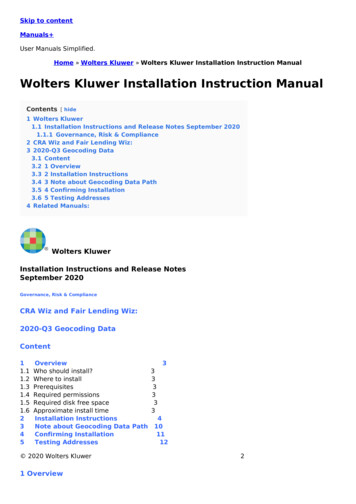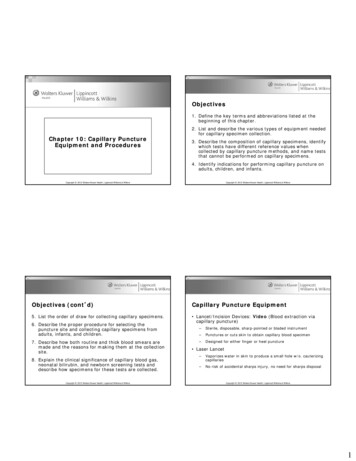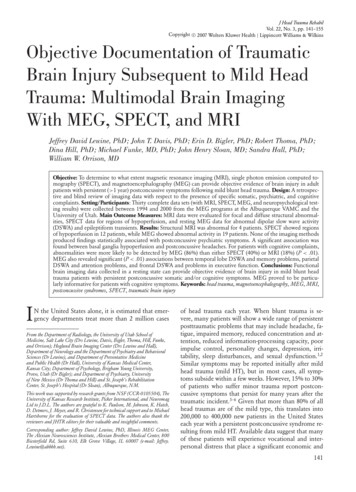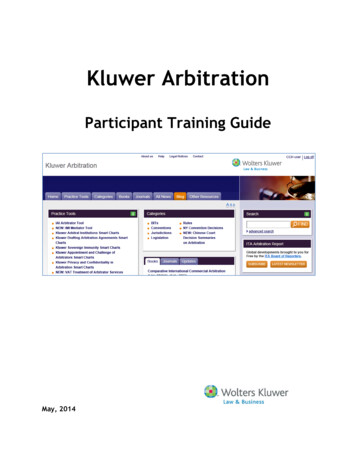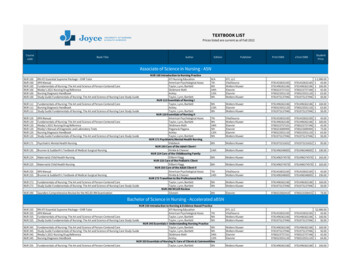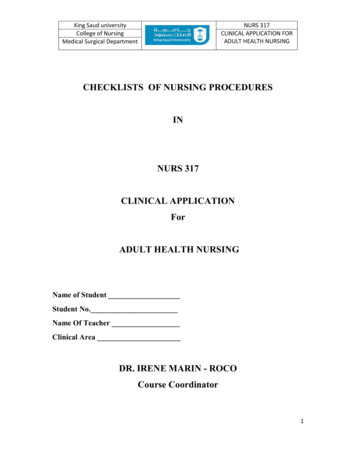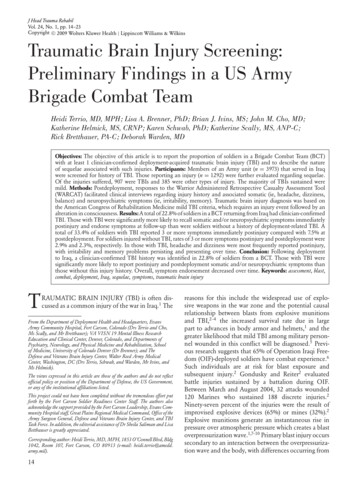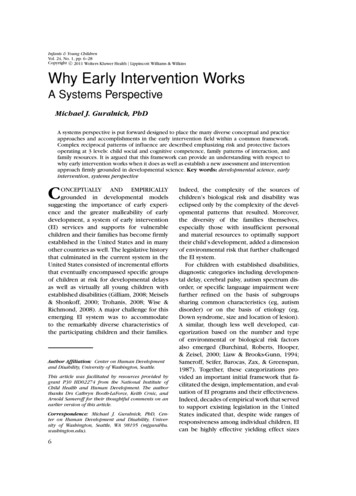
Transcription
LWW/IYCIYC200059December 10, 201020:38Char Count 0Infants & Young ChildrenVol. 24, No. 1, pp. 6–28c 2011 Wolters Kluwer Health Lippincott Williams & WilkinsCopyright Why Early Intervention WorksA Systems PerspectiveMichael J. Guralnick, PhDA systems perspective is put forward designed to place the many diverse conceptual and practiceapproaches and accomplishments in the early intervention field within a common framework.Complex reciprocal patterns of influence are described emphasizing risk and protective factorsoperating at 3 levels: child social and cognitive competence, family patterns of interaction, andfamily resources. It is argued that this framework can provide an understanding with respect towhy early intervention works when it does as well as establish a new assessment and interventionapproach firmly grounded in developmental science. Key words: developmental science, earlyintervention, systems perspectiveCONCEPTUALLY AND EMPIRICALLYgrounded in developmental modelssuggesting the importance of early experience and the greater malleability of earlydevelopment, a system of early intervention(EI) services and supports for vulnerablechildren and their families has become firmlyestablished in the United States and in manyother countries as well. The legislative historythat culminated in the current system in theUnited States consisted of incremental effortsthat eventually encompassed specific groupsof children at risk for developmental delaysas well as virtually all young children withestablished disabilities (Gilliam, 2008; Meisels& Shonkoff, 2000; Trohanis, 2008; Wise &Richmond, 2008). A major challenge for thisemerging EI system was to accommodateto the remarkably diverse characteristics ofthe participating children and their families.Author Affiliation: Center on Human Developmentand Disability, University of Washington, Seattle.This article was facilitated by resources provided bygrant P30 HD02274 from the National Institute ofChild Health and Human Development. The authorthanks Drs Cathryn Booth-LaForce, Keith Crnic, andArnold Sameroff for their thoughtful comments on anearlier version of this article.Correspondence: Michael J. Guralnick, PhD, Center on Human Development and Disability, University of Washington, Seattle, WA 98195 (mjgural@u.washington.edu).6Indeed, the complexity of the sources ofchildren’s biological risk and disability waseclipsed only by the complexity of the developmental patterns that resulted. Moreover,the diversity of the families themselves,especially those with insufficient personaland material resources to optimally supporttheir child’s development, added a dimensionof environmental risk that further challengedthe EI system.For children with established disabilities,diagnostic categories including developmental delay, cerebral palsy, autism spectrum disorder, or specific language impairment werefurther refined on the basis of subgroupssharing common characteristics (eg, autismdisorder) or on the basis of etiology (eg,Down syndrome, size and location of lesion).A similar, though less well developed, categorization based on the number and typeof environmental or biological risk factorsalso emerged (Burchinal, Roberts, Hooper,& Zeisel, 2000; Liaw & Brooks-Gunn, 1994;Sameroff, Seifer, Barocas, Zax, & Greenspan,1987). Together, these categorizations provided an important initial framework that facilitated the design, implementation, and evaluation of EI programs and their effectiveness.Indeed, decades of empirical work that servedto support existing legislation in the UnitedStates indicated that, despite wide ranges ofresponsiveness among individual children, EIcan be highly effective yielding effect sizes
LWW/IYCIYC200059December 10, 201020:38Char Count 0Early Intervention Systems Perspectiveaveraging 0.50 to 0.75 SDs (Guralnick, 1998).More recent work, often using well-designedrandomized clinical trials, continues to provide support for the benefits of EI includingchildren at biological and environmental risk(Landry, Smith, Swank, & Guttentag, 2008;Love et al., 2005; Ludwig & Phillips, 2008),children with autism (Dawson et al., 2010;Howlin, Magiati, & Charman, 2009), and children with heterogeneous developmental delays including those with Down syndrome(Guralnick, 2005a; Thomaidis, Kaderoglou,Stefou, Damianou, & Bakoula, 2000).As might be expected, close examinationof the EI protocols for these and numerousother studies reveals an unusual level of diversity with respect to conceptual frameworks,goals, and intervention approaches. To someextent, these wide-ranging differences reflectthe special concerns of diverse subgroups ofvulnerable children and their families, manypresenting with unique sets of risks and developmental patterns associated with specificdevelopmental periods. Moreover, new approaches to EI have emerged regularly overthe years, resulting from translational effortsbased on new conceptual frameworks andempirical findings.At a different level, general systems guidelines are available that have provided somelevel of coherence and consistency to thesediverse EI practices, including many of the essential structural features emphasized in current legislation for EI (Bruder, 2010; Guralnick& Conlon, 2007; Hauser-Cram & Warfield,2009). Systems features such as adopting afamily-centered approach, requiring individualized interventions, and ensuring coordination of services supported by a research base,in addition to generally agreed-upon valuesand principles, have now achieved international consensus (Guralnick, 2008). Nevertheless, an observer attempting to understandthe field can easily become overwhelmedwith the myriad of intervention details andconceptual frameworks encountered, especially in view of the many disciplines and service agencies involved in EI. In fact, it is quitepossible that the manner of growth of the EI7field and resulting diversity made it extremelydifficult to detect shared themes or developan overarching vision capable of organizingand analyzing the many diverse approachesand accomplishments of EI within a commonframework. In this article, I argue that it isnow possible to achieve such a framework inthe form of a systems approach that is firmlygrounded in developmental science. It is further suggested that this systems frameworkcan provide an understanding with respect towhy EI works as well as establish directions toimprove the effectiveness of EI practices.SYSTEMS PERSPECTIVEA systems orientation has been centralto numerous models of child development(Lerner, Theokas, & Bobek, 2005; Sameroff,2010). Fundamental to these models is arecognition of the hierarchical organizationof development and an effort to understandthe mechanisms through which componentsof the system interact with one another toform subsystems that combine and recombine to create an ever-increasing complex pattern of developmental growth. Defining theprocesses through which biological mechanisms, especially those based on genetic factors, interact with environmental events toinfluence development has also been a coreconcept of these systems models (Hanson &Gottesman, 2007; Meaney, 2010). The transactional model (Sameroff, 2009), the developmental biological systems view (Gottlieb,Wahlstein, & Lickliter, 1998), the organizational perspective (Cicchetti & Tucker, 1994;Rutter & Sroufe, 2000), developmental systems theory (Ford & Lerner, 1992), ecological theory (Bronfenbrenner, 2001; Bronfenbrenner & Morris, 1998), the parenting process model (Belsky, 1984), and the dynamicsystems theory (Thelen & Smith, 1998) aresome of the key systems models in this tradition. These models have all contributed toefforts to understand atypical child development, the most influential of which is thedevelopmental psychopathology approach(Cicchetti, 2006; Lewis, 2000).
LWW/IYCIYC2000598December 10, 201020:38Char Count 0INFANTS & YOUNG CHILDREN/JANUARY–MARCH 2011Figure 1. The 3 levels of the developmental systems approach illustrating their interrelationships andreciprocal influences including the effects of stressors on the system.The developmental systems approach(DSA) (Guralnick, 2005b) discussed in thisarticle is entirely compatible with these systems perspectives. However, a distinguishingfeature of the DSA is its goal to understandthe developmental mechanisms that areinvolved in promoting a child’s developmentin the context of EI for vulnerable childrenand their families. As will be seen, for thisto be accomplished, an integration of thedevelopmental science of normative development, the developmental focus on riskand disability, and intervention science isessential.By way of overview, the DSA involves attention to 3 interrelated levels that reflect thisintegration (see Figure 1). First, attention isrequired at the level of child development,complete with an understanding of how children utilize their growing developmental resources and organizational processes to expand their social and cognitive competencethroughout early childhood. Second, the DSArequires the identification of environmentalinfluences that support children’s emergingsocial and cognitive competence as governedby a family’s pattern of interactions involvingthe child. This pattern of interactions dependson many factors including adjustments byfamilies to accommodate to the unique constellation of their child’s developmental andbehavioral characteristics so necessary to support optimal child development (representedby the dotted arrow from the level of childdevelopment to the level of family patterns ofinteraction). The DSA also recognizes the potential moderating influence of each child’sunique characteristics on these family patterns (represented by the dashed line inFigure 1). Clearly, similar family patterns of interaction can have diverse effects on childrenwith different child characteristics. Third, theDSA requires an identification of those familyresources that, in many respects, determineand are available to support optimal familypatterns of interaction.From the perspective of EI programs, asindicated in Figure 1 by the solid arrowsflowing from the level of child development,an essential requirement in developing EIprograms within the DSA framework is toconduct an analysis of those family patternsof interaction and family resources that maybe unusually stressed or perturbed by the
LWW/IYCIYC200059December 10, 201020:38Char Count 0Early Intervention Systems Perspectivepresence of a child at biological risk or onewith a disability. That is, for a variety of reasons discussed later, many of the adjustmentsby families to their child’s characteristics essential to maintain optimal development (asrepresented by the dotted arrow) may not occur or may be insufficient (as represented bythe solid arrows). As a consequence, stressors created by children at biological risk orwith a disability create increasingly adverseeffects (risks) on family patterns of interaction over time and, ultimately, children’s cognitive and social competence. Moreover, theDSA also accounts for those circumstances inwhich insufficient family resources exist wellbefore a child is born. In this instance, limitedfamily resources may directly adversely influence family patterns of interaction (environmental risk) and, as a consequence, also affectchildren’s social and cognitive competence.Each of the 3 levels depicted in Figure 1, themany risk and protective factors associatedwith each level, and the interrelationships andreciprocal influences within and across levelsare discussed later to provide a basis for understanding the mechanisms through whichEI operates to generate its effects. Taken together, within the framework of the DSA, it isproposed that the central task of EI is to establish or restore family patterns of interaction toas optimal a level as possible.LEVEL OF CHILD DEVELOPMENTChildren’s development is conceptualizedwithin the DSA framework in terms of trajectories of ever-increasing social and cognitive competence over time. Competencein these 2 interrelated areas becomes manifest when children attempt to carry out specific goals. The nature and sophistication ofthese goals change dramatically throughoutearly childhood but the organizing power ofgoal-directed behaviors is apparent even in infancy (Woodward, 2009). As conceptualizedwithin the DSA, social and cognitive competence is dependent on an array of developmental resources and organizational processes (see Figure 2) that develop at a rapid9pace throughout the early childhood period.Developmental resources are domain-specificabilities, skills, and knowledge that have beenwell defined and effectively measured. Theseinclude conventionally organized domains ofcognition, language, motor, social-emotional,and sensory-perceptual development. Developmental studies of young children have revealed the details of how children call uponthese developmental resources to supporttheir emerging competencies during goaloriented activities. Indeed, a major contribution of the field of child development inrecent decades has been to identify the array of associations that exist between thesedomains (developmental resources) and children’s competence (McCartney & Phillips,2006). Vocabulary growth, increases in syntactic complexity, and the ability to understand the intentions of others and relatedmental states provide just a glimpse into someof the important language and cognitive resources that become available to young children over time. The carefully documented anddescribed developmental trajectories of motor, social-emotional, and sensory-perceptualdomains provide a correspondingly rich arrayof developmental resources. Although capable of being measured separately, these developmental resources are clearly interdependent. As suggested by systems models notedearlier, these resources combine and recombine both within and between domains, becoming continuously integrated into a hierarchy of more complex forms in support of children’s social and cognitive competence.Organizational processesAs important as these developmental resources are to children’s developing socialand cognitive competence, successful goaldirected behavior requires the involvementof processes operating at a different level.Specifically, and as further conceptualized inthe DSA, these developmental resources areharnessed and organized by a set of organizational processes during goal attainmentactivities. The following 5 organizational
LWW/IYCIYC20005910December 10, 201020:38Char Count 0INFANTS & YOUNG CHILDREN/JANUARY–MARCH 2011Figure 2. Model illustrating how organizational processes and developmental resources, framed by a goalstructure, constitute the basis for a child’s social and cognitive competence.processes have been identified as central contributors to children’s competence: (1) executive function (emphasizing higher-order cognitive processes that serve to organize developmental resources and other organizationalprocesses to maintain goal orientation) (seeBanich, 2009, as well as Anderson, 2002,and Welsh, Friedman, & Spieker, 2005); (2)metacognition (emphasizing awareness andknowledge of task relevant problem-solvingstrategies) (see Kuhn, 2000, and Pintrich,2000); (3) social cognition (emphasizing components of social tasks including encodingsocial information, interpreting that information, and generating prosocial responses)(see Beauchamp & Anderson, 2010; Crick &Dodge, 1994; Lemerise & Arsenio, 2000; RoseKrasnor, 1997; Yager & Ehmann, 2006); (4)motivation (emphasizing mastery motivationand reward systems relevant to goal selectionand task persistence) (see Morgan, MacTurk,& Hrncir, 1995); and (5) emotion regulation(emphasizing the effortful process involvingappraisals of emotional experiences and strategy generation to maintain goal orientation)(see Eisenberg & Spinrad, 2004, and Rothbart & Rueda, 2005). These complex organizational processes can also be measured effectively, but the task is admittedly far moredifficult. Nonetheless, overall assessments ofeach organizational process are available asare measures of specific components that constitute each process (eg, attentional shiftingand inhibition for executive function; encoding and availability of a repertoire of prosocial responses for social cognition). Similar todevelopmental resources, organizational processes are characterized by interdependenceand even sharing of components (eg, inhibition component being relevant to both executive function and emotion regulation) (Beer& Ochsner, 2006; Kaplan & Berman, 2010).Points key to this brief summary of organizational processes are that these processesare engaged when children participate in goaloriented activities, have developmental trajectories that can be measured reliably, and arehighly interrelated with one another at manylevels. Although it is beyond the scope ofthis article to provide details, as is the casefor children’s developmental resources, theseprocesses are strongly associated with children’s developing social and cognitive competence. It should also be noted that despitebeing conceptualized at the behavioral level,the systems features of the DSA have beeninfluenced by and are entirely compatiblewith contemporary neurobiological systemsmodels that emphasize functional connectivity, regional specialization, and interactions
LWW/IYCIYC200059December 10, 201020:38Char Count 0Early Intervention Systems Perspective11among neural subsystems and circuits (Blair,2002; Johnson, 2001; Yeates et al., 2007).To be sure, each of the developmentalresources and organizational processes displays wide individual differences. Indeed, inadequate growth or atypical patterns in achild’s developmental resources or organizational processes can constitute risk factors that are capable of compromising theexpected and predictable trajectory of children’s social and cognitive competence. Atthe same time, other developmental resourcesand organizational processes can serve as protective factors, in the sense that they continue to promote children’s developing competence even in the face of this adversity. Indeed, there are many pathways to goal attainment and competence at the level of child development (Cicchetti, 2006). As will be discussed, within the DSA, constructing profilesof children’s developmental resources and organizational processes is an essential component of EI programs for vulnerable children.Such an assessment not only provides information with respect to a child’s current developmental status but also serves to highlightareas of special concern that may require substantial adjustments in a family’s pattern of interactions to optimize their child’s development.ate a framework compatible with the goalsof EI (Guralnick, 2005b). As indicated earlier, in instances in which specific family patterns of interaction appear to be less than optimal with respect to promoting a child’s development, the ability to address those riskfactors generated by stressors at the level ofchild development or due to already-existinglimited family resources (environmental risk)comprehensively is seen as the key to effective EI practices.Within the DSA, 3 types of family patterns of interaction that promote children’ssocial and cognitive competence have beenidentified: (1) parent-child transactions, (2)family-orchestrated child experiences, and (3)health and safety provided by the family (seeFigure 3). As noted briefly later, each of thesefamily patterns of interaction and their components have well-documented associationswith children’s social and cognitive competence at the level of child development as wellas with virtually all aspects of children’s developmental resources and organizational processes. Indeed, establishing these betweenlevel relationships and the details of their associations has been another of the importantaccomplishments of the developmental science of normative development in the pastquarter century (McCartney & Phillips, 2006).LEVEL OF FAMILY PATTERNS OFINTERACTIONParent-child transactionsThe developmental science of normativedevelopment has reached a point in whichenvironmental factors that influence the variable but yet generally predictable patterns ofchildren’s social and cognitive competencecan be identified with reasonable confidence(eg, Bradley & Corwyn, 2004; Collins, Maccoby, Steinberg, Hetherington, & Bornstein,2000). Indeed, for vulnerable children andtheir families, as elaborated upon later inthis article, one contribution of the DSA hasbeen to organize these well-established environmental factors based on the developmental science of normative development in theform of family patterns of interaction to cre-As conceptualized within the DSA, parentchild transactions, the first component offamily patterns of interaction, consist ofa series of “relationship processes.” Theserelationship processes are thought to gradually develop over time through frequentand extended sequences of successful andsynchronous parent-child exchanges (seeFeldman, 2007). In so doing, each participantbegins to recognize his or her role in therelationship and, in a real sense, a sharedpsychological state emerges with clear expectations about each relationship process(Tomasello & Carpenter, 2007). Parents,of course, bring certain attitudes, skills,and abilities to these relationship processes
LWW/IYCIYC20005912December 10, 201020:38Char Count 0INFANTS & YOUNG CHILDREN/JANUARY–MARCH 2011Figure 3. The developmental systems approach framework illustrating the influence of the 3 family patterns of interaction with their key components.(Papoušek & Papoušek, 2002) and capitalizeon children’s eagerness to participate (Shonkoff & Phillips, 2000). Indeed, a substantialdevelopmental literature exists with respectto the importance of parents’ sensitivity andresponsiveness to their child’s behavior, thesignificance of positive affect in those adaptive interactions, and the need to be engagedwith their child for sufficient periods of timeso that the developmental value of relationships can be realized (Collins et al., 2000).These parent characteristics form the basisfor the following 3 relationship processesproposed within the DSA as constituting thekey components of parent-child transactions:(1) discourse framework, (2) instructionalpartnership, and (3) socioemotional connectedness. It is further suggested that it is these3 relationship processes that give substanceand meaning to parent-child transactions andconstitute an essential structure that enablesthese relationships to promote various dimensions of children’s social and cognitivecompetence (see Figure 3).A discourse framework represents thatcomplex,constantlyevolvingsocialcommunication process between parentand child, often occurring in the context offamily routines (Fiese & Spagnola, 2007). Itis through these frequent social exchangesthat children seek and acquire informationneeded to satisfy their interests and supporttheir goal-directed behavior. “Conversations”ranging from social referencing exchangesto extended discussions of the child’s ownand others’ mental states are examples ofthis type of process that evolves over time(Adrian, Clemente, & Villanueva, 2007;Chouinard, 2007; Mundy & Sigman, 2006;Thompson, 2006). This discourse framework,with the often intense give-and-take seriesof exchanges, forms a relationship process
LWW/IYCIYC200059December 10, 201020:38Char Count 0Early Intervention Systems Perspectivewith expectations by both partners that parents will do everything possible to provideessential information when requested to doso. It is in this context that parents are able togauge their child’s knowledge and interestsand introduce new knowledge through aprocess of conversational elaborations. Theconsequence is appropriate adjustmentsto their child’s characteristics (emphasizedby the dotted arrow from level of childdevelopment to the level of family patternsof interaction in Figures 1, 3, and 4) and thecreation of circumstances that press for achild’s further development of their socialand cognitive competence.This process is usually initiated or at leastprompted by the child but can easily lead totransactions in which parents become moredominant and begin to structure interactionsthat are now clearly instructional in form. Infact, independent of child-initiated discourse,it is parents who frequently initiate diverse instructional activities, especially if the child appears to be having difficulty with a particulartask. Over time parents and children developan instructional partnership, again with reliable and clear expectations emerging on thepart of both partners. In this case, the parent is interested in providing and the childis interested and willing to accept this typeof more formal instructional support. A substantial literature exists demonstrating the formation and existence of such an instructionalpartnership including the ability of most parents to sensitively organize and scaffold inan affectively warm and nonintrusive mannera pattern of interactions capable of enhancing their child’s knowledge and skills (Vygotsky, 1978). Evaluating their child’s “region ofsensitivity to instruction,” defining attainablegoals and subgoals, and shifting levels of support for a problem in a contingent manneralong with the child’s enthusiastic participation in the process constitute many of the elements of a successful instructional partnership (Pratt, Kerig, Cowan, & Cowan, 1988;Wood & Middleton, 1975). It is this process ofadjustment that allows children to internalizesolutions and to become more independent13problem solvers. A similar process may alsobe operating for promoting certain aspects ofchildren’s social competence (see Grusec &Davidov, 2010).Finally, specific forms of sensitive, responsive, and affectively warm interactions displayed by parents that continue to be presentover time and are evident in different contextscreate the third relationship process, referredto as socioemotional connectedness. Kochanska (2002) has described a shared or mutuallyresponsive orientation that emerges betweenparent and child. This is a powerful, cooperative, eager relationship that takes many forms.Indeed, the formation of a secure attachmentis one critical manifestation of the emergenceof this larger relationship process, especiallywhen parents are sensitive and responsive tochildren’s distress signals (Ainsworth, Blehar,Waters, & Wall, 1978; Leerkes, Blankson, &O’Brien, 2009). Of importance, the mutual,cooperative, shared set of expectations helpsto support the other 2 types of parent-childtransactions (Laible & Thompson, 2000).These 3 types of parent-child transactions also highlight the fact that a key construct such as sensitive-responsiveness acquires meaning in the context of these relationships (eg, questions, affirmations, support child’s focus), different combinations ofwhich may be compatible with 1 or more relationship process (Landry, Smith, & Swank,2006). As a consequence, the quality of the3 different relationships may well vary withina given parent-child dyad. This conceptualization is consistent with the domain-specificapproach put forward by Grusec and Davidov (2010), focusing on children’s socialization. Although the distinctions among the 3relationship processes constituting parentchild transactions are meaningful and useful,the mutual support and often effortless shifting among them during the ebb and flow offamily interactions and routines further enhance the transactional processes.Connections among all 3 relationship processes that constitute parent-child transactions and the level of child development have been well established. In fact,
LWW/IYCIYC20005914December 10, 201020:38Char Count 0INFANTS & YOUNG CHILDREN/JANUARY–MARCH 2011Figure 4. The developmental systems approach framework illustrating the role of family resources as thefoundation for the 3 family patterns of interaction.virtually all aspects of children’s developmental resources and organizational processeshave been linked to these relationship processes in numerous investigations. A comprehensive review is beyond the scope of this article, but noteworthy examples can be foundin the work of Chouinard (2007) for the discourse framework and in the work of Landryand her colleagues with respect to the instructional partnership (see Dieterich, Assel,Swank, Smith, & Landry, 2006). An excellentreview of these associations for the relationship process of socioemotional connectedness is also available (Thompson, 2006).Family-orchestrated child experiencesThe contributions of these 3 forms of intense and intimate parent-child transactionsto a child’s development cannot be underestimated. Yet, parents can further contributeto their child’s development by orchestratinga series of experiences that extend beyondthese relationships. As noted in Figure 3, theseexperiences include introducing the child tothe parent’s own social network, helping toarrange a peer social network for their child,and providing as stimulating an environmentas possible (eg, ensuring the availability ofdevelopmentally appropriate toys and materials). Involvement in community activities ofall sorts (field trips, shopping, holiday events,etc) also provides numerous opportunities fordevelopmental growth. Of course, the properselection of child care and preschool programs is of critical importance as well, especially in view of the substantial amount oftime many children now spend in those settings. Similarly, it is parents who are responsible for recognizing and supporting theirchild’s special interests as well as recognizing and addressing their child’s special needs.All of these family-orchestrated child experiences have established associations with
LWW/IYCIYC200059December 10, 201020:38Char Count 0Early Intervention Systems Perspectivevarious components at the level of childdevelopment (eg, Bradle
LWW/IYC IYC200059 December 10, 2010 20:38 Char Count 0 8INFANTS &YOUNG CHILDREN/JANUARY-MARCH 2011 Figure 1. The 3 levels of the developmental systems approach illustrating their interrelationships and
